Original URL: https://www.theregister.com/2007/12/03/review_intel_qx9770_x48/
Intel 'Penryn' Core 2 Extreme QX9770 and X48 chipset
Say hello to the 1600MHz desktop FSB
Posted in Channel, 3rd December 2007 11:02 GMT
2007's Top Products Intel has been busy sending out a batch of 'Penryn' Core 2 Extreme QX9770 processors to every tech site in the known universe, and if you take a look at some of the reviews that have popped up you’ll spot a common theme. The QX9770 is the first desktop processor to run on a 1600MHz frontside bus (FSB) but right now there are no desktop chipsets that support this new speed.
On the server side, Intel has 1600MHz covered with its 5400 series of Xeon chips and chipsets, but we’re in new territory on the desktop as the X38 chipset's FSB tops out at 1333MHz.
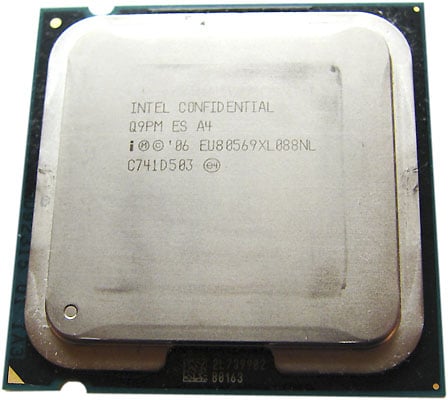
Intel's Core 2 Extreme QX9770: Penryn-plus?
Early in 2008, Intel will launch a brand new chipset called the X48 which appears to be exactly the same as X38 but with the addition of the 1600MHz FSB - which makes us rather wonder why Intel didn’t simply name the new spin as X38 2.0. For the time being, most reviewers have been in a predicament as the only motherboards that support the QX9770 use either the X38 or the P35 chipset and have a Bios that has been modified by the motherboard manufacturer to accommodate the faster FSB.
Happily, Register Hardware has a trick up its sleeve: we have got our mitts on an Asus P5E3 Premium motherboard which uses X48 chipset. So we’re in a position to put the QX9770 through its paces using an Asus P5K3 Deluxe with a P35 chipset, a Gigabyte GA-X38T-DQ6 with an X38, and the P5E3 with the X48.
The QX9770 has a clock speed of 3.20GHz (8 x 400MHz) compared to the 3.00GHz QX9650 (9 x 333MHz) we reviewed last month. The TDP has increased from 130W to 136W, but other than that the two chips have identical specifications with four cores and support for the new SSE 4 instruction set. They're both made using a 45nm fabrication process.
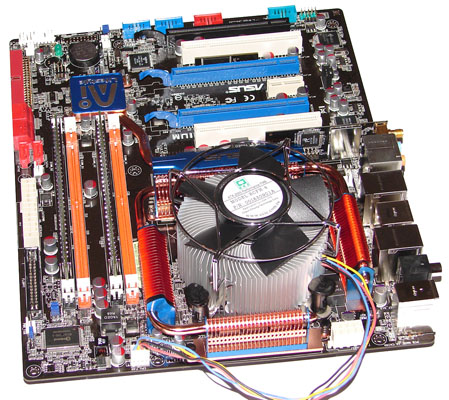
Asus' P5E3 Premium: packing the X48 chipset
Starting with the Gigabyte motherboard, because it arrived first, we installed beta Bios F4a and ran the QX9650 to give us a baseline for comparison. PCMark05 is a good all-round benchmark for system performance, while DivX 6.7 uses SSE 4 to fully stress the latest processors. Finally, encoding AAC music files with iTunes gives a decent all-round idea of how much horsepower you’ve got in your PC.
The QX9650 performed admirably at the stock 3.00GHz, but we were unable to overclock it on the Gigabyte as the beta Bios was a bit rudimentary.
PCMark05 Test - X38 Chipset
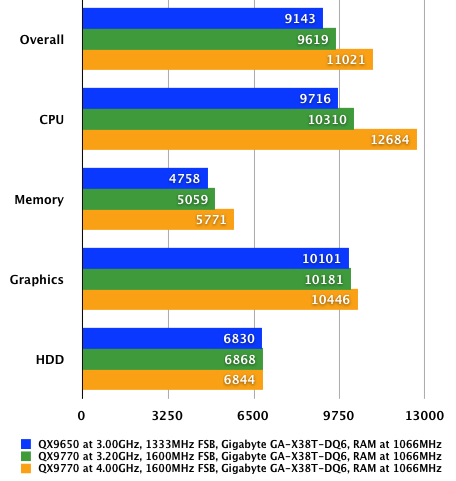
Longer bars are better
Switching to the QX9770 boosted performance by a small margin thanks to the extra 200MHz but it wasn’t at all clear that the move to the 1600MHz FSB yielded any extra performance in its own right.
iTunes AAC Conversion Test - X38 Chipset
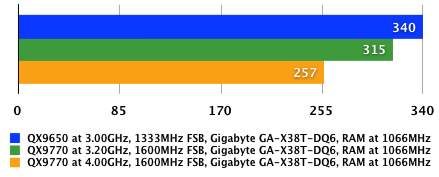
Time in seconds to convert 150MB of MP3 files to AAC
Shorter bars are better
Time to overclock the QX9770, and as we had an Extreme Edition processor with unlocked multiplier we took the easy option and raised the multiplier to 9x and the clock speed to 3.6GHz. The performance increase was linear so we had another go and bumped the multiplier to 10x to give a 4GHz clock speed. This made the system slightly unstable so we had to increase the Northbridge and CPU voltages slightly to sort things out and now the QX9770 positively flew along.
DivX 6.7 Recode Test - X38 Chipset
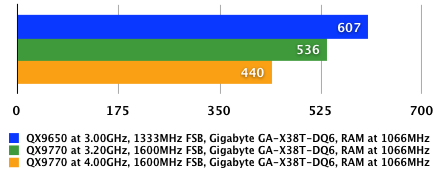
Time in seconds to recode a 350MB AVI file
Shorter bars are better
The power draw at the socket increased by an enormous 115W under extreme load at the 4GHz speed, but despite that we had no trouble keeping the CPU cool with a Zalman heatsink, although we did have to increase the speed of the fan controller by a moderate amount.
Next up was the Asus P5K3 Deluxe with P35 chipset and DDR 3 memory support. Clock-for-clock the P35 yielded lower memory and graphics performance in PCMark05 than the X38 which was something of a surprise as the AMD ATI Radeon HD 3870 surely wasn’t restricted by the PCI Express (PCIe) bus. The X38 board has PCIe 2.0 while P35 is stuck with the original PCIe bus but both offer plenty of bandwidth and the P35 DDR 3 memory controller is surely very similar to the one on the X38.
PCMark05 Test - P35 Chipset
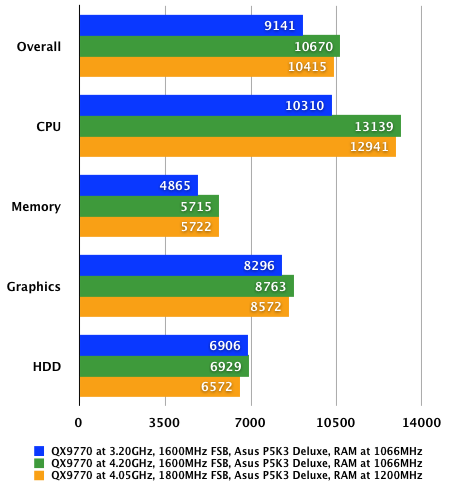
Longer bars are better
CPU performance at 3.20GHz in PCMark05 was identical on the P35, which was gratifying, and the time taken for DivX encoding was effectively identical but in iTunes the X38 had a significant edge.
iTunes AAC Conversion Test - P35 Chipset
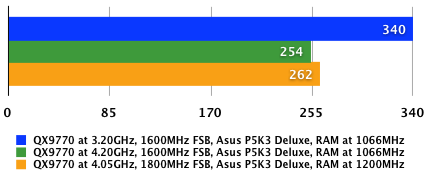
Time in seconds to convert 150MB of MP3 files to AAC
Shorter bars are better
We had more options for overclocking with the Asus P35 Bios as we had clock multipliers that went up in 0.5x steps so we were able to run the multiplier at 10.5x for a clock speed of 4.20GHz. At this speed the DivX test wouldn’t run and we had a similar situation when we raised the FSB to 1800MHz with a multiplier of 9x to get a clock speed of 4.05GHz. CPU performance was great in both cases but system performance was uninspiring compared to the Gigabyte X38.
DivX 6.7 Recode Test - P35 Chipset
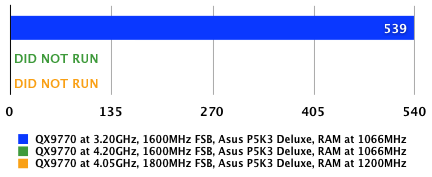
Time in seconds to recode a 350MB AVI file
Shorter bars are better
And so we come to the Asus X48 motherboard which is the natural partner for the QX9770. We ran the processor at 3.20GHz with PC3-1333 memory at 1066MHz, just as we had with the other two systems and achieved results that were very similar - but slightly slower- than the X38. At 4.00GHz the X48 once again mirrored the X38 and despite our best efforts with monstrous voltages through the Northbridge and memory the QX9770 had no intention of running any faster.
PCMark05 Test - X48 Chipset
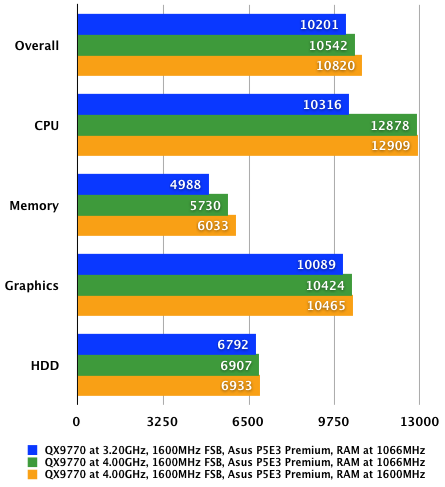
Longer bars are better
The Asus X48 is the type of motherboard that will delight overclockers as it caps the CPU voltage at 1.70V but if you install a jumper you can raise the voltage to 2.1V. We plan on using this CPU in the future so we kept the voltage to a lowly 1.475V but if you spend £699 on a QX9770 and fancy trying more than two volts do please let us know how you get on.
iTunes AAC Conversion Test - X48 Chipset
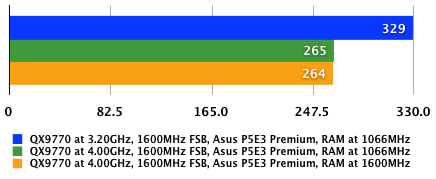
Time in seconds to convert 150MB of MP3 files to AAC
Shorter bars are better
As a final test we swapped out the OCZ PC3-1333 memory for some OCZ PC3-1600 and ran it at full speed to make sure that the 4.00GHz CPU wasn’t being starved of memory bandwidth however performance increased by only the smallest of margins.
DivX 6.7 Recode Test - X48 Chipset
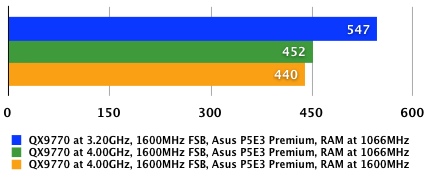
Time in seconds to recode a 350MB AVI file
Shorter bars are better
Verdict
Intel's X48 chipset appears to be little more than a carefully selected X38, and our enthusiasm for the new chipset was washed away in a torrent of disappointment. But the Core 2 Extreme QX9770 is a completely different story. It’s unbelievably fast and it overclocks to 4.0GHz with the bare minimum of cooling. Intel looks to be in for a good 2008, and no doubt that’s why it decided to send us a the QX9770 just before Christmas, just so it could spread the cheer around.